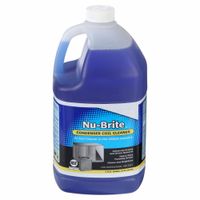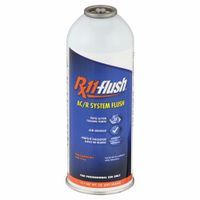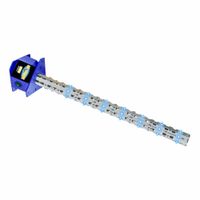Call +(254) 703 030 000 / 751 483 999 / 721 704 777
- Home
- Hvac And Refrigeration
- Hvac Cleaning Chemicals Equipment Kits
.....Read More
Frequently Asked Questions
What are the best chemicals for cleaning HVAC coils?
The choice of chemicals for cleaning HVAC coils depends on the type of coil and the nature of the buildup. For general cleaning and light dirt, a foaming alkaline coil cleaner is often effective. These cleaners typically contain detergents and chelating agents to break down grease and grime. For heavily soiled coils or those with mold and mildew, a more aggressive acidic cleaner may be necessary, but these should be used with caution as they can be corrosive to certain metals if not used properly. Biological contaminants like mold and bacteria can also be addressed with antimicrobial cleaners or disinfectants designed for HVAC systems. Always ensure the cleaner is safe for the coil material (e.g., aluminum, copper) and follow manufacturer guidelines for dilution, application, and rinsing to prevent damage and ensure safety. Proper ventilation and personal protective equipment are crucial when using any cleaning chemicals.
How often should HVAC systems be cleaned?
HVAC systems should generally be cleaned at least once a year, ideally in the spring before the cooling season or in the fall before the heating season begins. This regular maintenance helps ensure optimal performance, energy efficiency, and good indoor air quality.
However, certain factors can necessitate more frequent cleaning. If you have pets that shed, allergies, or asthma, quarterly or semi-annual cleaning might be beneficial to minimize allergens and improve air quality. Homes with smokers or those undergoing significant renovation projects that generate a lot of dust also warrant more frequent cleaning.
Additionally, if you notice a decrease in airflow, unusual noises coming from your system, or a persistent musty odor, it's a strong indicator that your HVAC system, including ducts and coils, needs professional cleaning regardless of the last service date. Regular professional cleaning not only extends the lifespan of your unit but also helps prevent costly breakdowns and ensures your system runs as efficiently as possible, saving you money on energy bills.
What equipment is needed for HVAC coil cleaning?
Maintaining your HVAC system is crucial for optimal performance and air quality, and regular coil cleaning is a key part of that. To effectively clean HVAC coils, you'll need a range of equipment, varying depending on the type and extent of the cleaning job.
For a basic, routine cleaning, a high-quality coil cleaner solution is essential. These come in various formulations, some foaming to lift dirt and others acidic or alkaline for tougher grime. You'll also need a pump sprayer for even application of the cleaner, and a stiff brush, often specifically designed for coil fins, to agitate and loosen embedded dirt. A wet/dry vacuum is invaluable for removing loosened debris and standing water after rinsing.
For more thorough or professional cleaning, specialized equipment becomes necessary. A portable pressure washer with adjustable settings and a fan-spray nozzle can be used, but extreme care must be taken to avoid damaging the delicate fins. For heavily fouled coils, a steam cleaner can be effective in breaking down grease and stubborn contaminants. Additionally, a fin comb is often used to straighten bent fins, which can restrict airflow and reduce efficiency. Safety gear, including gloves and eye protection, should always be worn during any cleaning process to protect against chemicals and debris.
How do descaling chemicals work in HVAC systems?
Descaling chemicals, also known as scale removers or inhibitors, are used in HVAC systems to combat the buildup of mineral deposits (scale) that can accumulate in pipes, coils, and other components. This scale typically forms from hard water, which contains dissolved minerals like calcium and magnesium. Over time, scale buildup can significantly reduce the efficiency of the HVAC system by impeding heat transfer, increasing energy consumption, and potentially leading to component failure.
Descaling chemicals work through various mechanisms, depending on their composition. Acid-based descalers, such as those containing phosphoric, hydrochloric, or sulfamic acids, chemically react with the alkaline mineral deposits, dissolving them into a soluble form that can then be flushed away. Chelating agents, another type of descaling chemical, bind to the metal ions in the scale, forming stable, water-soluble complexes that prevent the minerals from precipitating and adhering to surfaces. Some descalers also include dispersing agents, which help to keep the loosened scale particles suspended in the water, preventing them from re-depositing. Inhibitors are often added to descaling formulations to protect the underlying metal surfaces of the HVAC components from corrosion during the descaling process. The specific choice of descaling chemical depends on the type of scale, the materials of construction in the HVAC system, and environmental considerations. Proper application and flushing are crucial to ensure effective scale removal and prevent damage to the system.
What is the role of ultraviolet disinfection in HVAC maintenance?
Ultraviolet (UV) disinfection in HVAC systems plays a crucial role in maintaining indoor air quality and system efficiency. UV-C light, specifically, is effective at disrupting the DNA and RNA of microorganisms like bacteria, viruses, and mold spores, rendering them inactive.
When integrated into HVAC units, UV lamps are typically placed in the air handling unit or ductwork, often near the evaporator coil. This strategic placement targets several key areas:1. **Coil and Drain Pan Sterilization:** The evaporator coil is a common breeding ground for mold and bacteria due to its cool, damp surface. UV-C light keeps the coil and drain pan clean by continuously sterilizing these surfaces, preventing the growth of biofilm and slime. This not only improves air quality by reducing airborne contaminants but also enhances the system's heat transfer efficiency, as a clean coil operates more effectively.
2. **Airborne Pathogen Reduction:** As air circulates through the HVAC system, it passes through the UV-C light zone. This exposure can significantly reduce the concentration of airborne pathogens, contributing to a healthier indoor environment. This is particularly beneficial in settings where air quality is paramount, such as healthcare facilities, schools, and offices.
3. **Odor Control:** By eliminating mold and bacteria that can produce foul odors, UV disinfection can also contribute to fresher indoor air.
4. **Reduced Maintenance:** A cleaner coil and drain pan can lead to less frequent manual cleaning, potentially extending the lifespan of certain HVAC components and reducing overall maintenance costs.In summary, UV disinfection in HVAC maintenance is a proactive measure that improves indoor air quality, enhances system efficiency, and can reduce the need for certain types of manual cleaning, ultimately contributing to a more comfortable and healthier indoor environment.
How do you use HVAC brushes and combs effectively?
To effectively use HVAC brushes and combs, start by disconnecting power to the unit for safety. For outdoor condenser coils, use a fin comb to straighten bent fins, gently working in one direction to avoid further damage. Then, use a soft bristle brush to remove loose debris, dust, and lint from between the fins. For indoor evaporator coils, which are often more delicate, a softer brush like a coil brush or a specialized evaporator coil cleaning brush is recommended. Gently brush away surface dirt, being careful not to damage the coil's delicate structure. For both types of coils, a vacuum with a brush attachment can be used after brushing to remove dislodged debris. Always work slowly and methodically, ensuring all accessible areas are cleaned. Regular cleaning with these tools improves airflow, increases efficiency, and extends the lifespan of your HVAC system.
What are the benefits of using heat exchanger cleaning equipment?
Using heat exchanger cleaning equipment offers several significant benefits:
Improved Efficiency: Over time, heat exchangers can accumulate fouling, scale, and deposits on their surfaces, which act as insulators and reduce heat transfer efficiency. Regular cleaning removes these layers, restoring the equipment to its optimal heat transfer capabilities. This leads to reduced energy consumption and lower operating costs.
Extended Equipment Lifespan: Fouling and corrosion can lead to premature wear and tear on heat exchanger components. By maintaining clean surfaces, the cleaning equipment helps prevent degradation and extends the operational life of the heat exchanger, delaying the need for costly replacements.
Reduced Downtime: Proactive cleaning schedules can prevent unexpected breakdowns caused by severe fouling or blockages. This minimizes unplanned downtime for maintenance and repairs, ensuring continuous operation and productivity.
Enhanced Safety: In some industries, certain types of fouling can pose safety risks, such as increased pressure drop or the potential for microbial growth. Regular cleaning mitigates these risks, contributing to a safer working environment.
Compliance with Regulations: Many industries have strict regulations regarding energy efficiency, emissions, and product quality. Maintaining clean heat exchangers helps companies comply with these standards, avoiding potential fines and ensuring smooth operations.
How do disinfectants and odor neutralizers work in HVAC systems?
Disinfectants and odor neutralizers play a crucial role in maintaining air quality within HVAC (Heating, Ventilation, and Air Conditioning) systems by addressing microbial growth and unpleasant smells. Disinfectants primarily work by destroying or inactivating microorganisms such as bacteria, viruses, fungi, and mold spores that can accumulate on HVAC components like coils, drain pans, and ductwork. These products often contain active ingredients like quaternary ammonium compounds, hydrogen peroxide, or bleach, which disrupt the cellular structure or metabolic processes of microbes, rendering them harmless. Applying disinfectants directly to contaminated surfaces helps prevent the recirculation of pathogens throughout a building, reducing the risk of airborne illnesses and allergic reactions.
Odor neutralizers, on the other hand, focus on eliminating or masking foul odors that can originate from mold, mildew, stagnant water, or volatile organic compounds (VOCs) within the HVAC system. Unlike air fresheners that merely cover up smells, true odor neutralizers work by chemically bonding with the odor-causing molecules, altering their structure, or encapsulating them so they can no longer be detected by the human olfactory system. Common mechanisms include adsorption (where porous materials trap odor molecules), oxidation (where chemicals break down odor molecules), or enzymatic action (where enzymes break down organic matter causing the smell). By removing the source of the odor, these products contribute to a fresher and more pleasant indoor environment, enhancing comfort for occupants.
What is the best method for flushing HVAC drain lines?
The best method for flushing HVAC drain lines involves using a wet/dry vacuum, a specialized pump, or a mixture of distilled vinegar and hot water.1. Wet/Dry Vacuum Method: This is generally considered the most effective and least messy. Attach the vacuum hose to the drain line opening (usually outside or near the HVAC unit). Seal the connection as tightly as possible to create good suction. Turn on the vacuum to pull out any clogs and accumulated sludge. This method is excellent for removing stubborn blockages.
2. Specialized Pump Method: HVAC technicians often use a specialized pump designed to clear condensate lines. These pumps create a surge of pressure that can dislodge blockages. If you have access to one, it's a very efficient way to clear the line.
3. Vinegar and Hot Water Method: For preventative maintenance or minor clogs, a mixture of distilled white vinegar and hot (not boiling) water can be effective. Pour about a cup of distilled white vinegar down the drain line (access point usually inside the unit). Let it sit for 30 minutes to an hour to break down algae and mold. Follow with a flush of several cups of hot water. This method is good for routine cleaning but might not clear severe clogs.Regardless of the method, it's important to turn off your HVAC unit before you begin. Regularly flushing your drain lines (every few months, especially during humid seasons) can prevent clogs, water damage, and unpleasant odors.
Are there any safety precautions when using HVAC cleaning chemicals?
When using HVAC cleaning chemicals, it's crucial to prioritize safety to prevent injury and ensure effective cleaning. Always wear appropriate personal protective equipment (PPE), including chemical-resistant gloves, eye protection (goggles or a face shield), and a respirator if recommended by the product's Safety Data Sheet (SDS) for vapor or mist protection. Ensure adequate ventilation in the work area to disperse fumes and prevent inhalation.
Read and strictly follow the manufacturer's instructions and SDS for each chemical. The SDS provides vital information on safe handling, storage, first aid measures, and disposal. Never mix different chemicals unless explicitly instructed, as this can create dangerous reactions or toxic fumes.
Before starting, disconnect power to the HVAC system to avoid electrical hazards. Protect surrounding areas from chemical overspray or spills. Have a spill kit readily available and know how to use it. In case of skin or eye contact, immediately flush with plenty of water and seek medical attention if irritation persists. Store chemicals in their original, labeled containers in a cool, dry, well-ventilated area, away from children and pets. Dispose of leftover chemicals and contaminated materials according to local regulations. Regular training on chemical safety and emergency procedures is also highly recommended for anyone handling these products.







